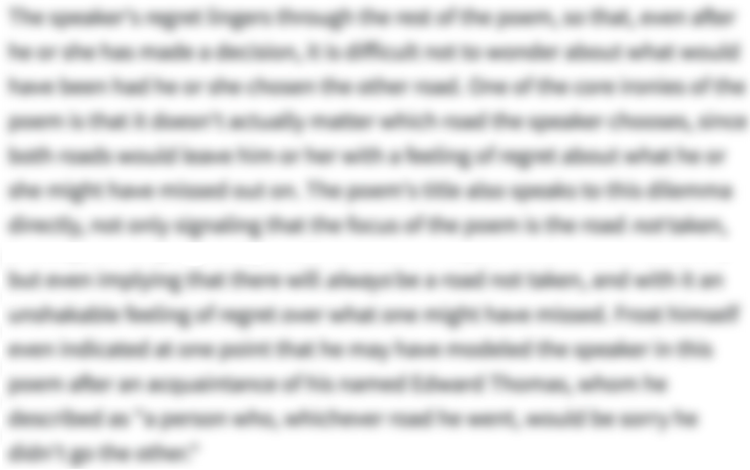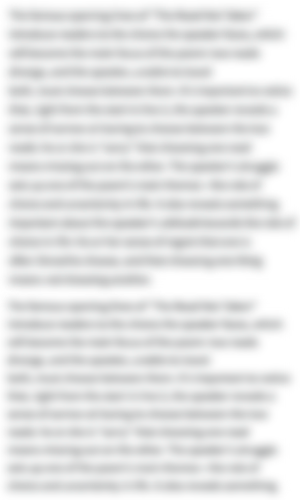-
“Once the World Was Perfect” Introduction
-
"Once the World Was Perfect" was written by former U.S. poet laureate Joy Harjo, a member of the Muscogee Creek Nation, and published in the 2015 collection Conflict Resolution for Holy Beings. The free verse poem condemns the divisive power of greed while also celebrating the unifying power of kindness. As the title suggests, the poem depicts a time when the world was "perfect" and human beings lived in harmony with each other and with the planet. Doubt and selfishness made people turn on each other, however, destroying the world and casting humankind into darkness. People are only able to rebuild what they destroyed by treating each other with compassion and working together, constructing a metaphorical ladder that leads to the "light" of a better future.
-
-
“Once the World Was Perfect” Summary
-
The speaker says that, long ago, there was nothing wrong in the world and human beings lived together in happiness and harmony. But people eventually stopped appreciating this perfect world as they should have. Unhappiness and dissatisfaction began to shake the ground, then dangerous, destructive doubt pierced through. Doubt tore apart the delicate, intricate web of connections between all of humanity (and/or between humanity and the natural world), allowing all sorts of dark emotions to escape out into the world. People ruined the vibrant, inspiring world they'd been given. Jealousy, fear, envy, greed, and hatred were like stones people threw at each other, eventually shattering the light of human progress. Everyone cast these stones; no one was blameless. The light of progress snuffed out, humanity was thrust back into the darkness in which the world began, blindly bumping into each other. People were left with nowhere to go for shelter because they couldn't get along and didn't know how to live together peacefully. Finally, one of those people bumbling around in the dark felt bad for another person and shared their blanket with them. This small act of kindness caused a spark that grew into a light that eventually pierced the surrounding darkness. People joined together to build a ladder in order to climb through this new opening. The first person who climbed up this ladder and into a new, brighter world was someone from the Wind Clan. Soon enough, people from other clans followed suit; generation after generation did the same, leading all the way up to this very moment and, the speaker says, to you.
-
-
“Once the World Was Perfect” Themes
-

The Destructive Nature of Jealousy and Greed
Joy Harjo's "Once the World Was Perfect" is a kind of creation myth that illustrates the corrupting influence of selfishness and ingratitude. Long ago, the speaker begins, "the world was perfect" and humankind was happy. However, in the poem's telling, this happiness didn't last; humanity failed to appreciate "the world we had been given," which was then quickly torn apart by negative emotions like "jealousy," "greed," "envy," and so forth. Failing to respect and appreciate both one another and the planet, the poem argues, thrusts humanity into isolating darkness.
Although the poem begins with the brief promise that long ago, "the world was perfect," its first images are ones of destruction. Unable to simply appreciate the happiness they'd been granted, the speaker says, people gave in to selfish desires for more. Discontent and Doubt, personified as demons, persuaded human beings to turn on one another, throwing stones labeled with a number of dark emotions: "jealousy […] fear, greed, envy, and hatred."
In the process, these stones "ruptured the web"—the intricate yet delicate series of connections between all people (and perhaps, between people and nature). The implication is that human beings' tendency towards selfishness and distrust limited the capacity for peace and progress. The stones put out the metaphorical "light" of humanity, leaving people to "bump[] into each other / In the dark." The speaker makes a point of saying that "no one was without a stone in his or her hand," emphasizing that everyone has this capacity for cruelty; no one was blameless in this stone-throwing.
However, in describing Discontent and Doubt as external forces that bewitched people, convincing them to destroy one another, the poem offers some absolution. It suggests that humanity has never been inherently evil; after all, we did once live happily together. The poem concludes that people must learn to overcome their most base instincts if they ever are to "live with each other" again.
Where this theme appears in the poem:- Lines 1-18
-

Unity, Kindness, and Hope
"Once the World Was Perfect" illustrates humankind's capacity for both immense cruelty and kindness. Though jealousy and hatred put out humanity's "light," this destruction granted the opportunity for people to take pity on and help one another. The poem closes with people working together, slowly and painstakingly, to "make a ladder" that led "into the next world." The poem thus offers hope for a better future built on cooperation, gratitude, and empathy.
The poem begins with humanity destroying itself through selfishness and greed, which tore apart the delicate web that bound all people together. Humanity was left with "no place to live," the speaker says, "since we didn't know / How to live with each other."
The speaker then relays how a single person's actions in such dark times provided the seed of hope for a better future. One person took pity on another and offered to share their blanket, creating a "spark of kindness" that then grew into the same light that humanity had previously snuffed out through its cruelty. The poem thus reiterates the power and importance of individual agency: just as every person participated in the world's destruction by throwing stones, one person's act of kindness was enough to spur the world's reconstruction.
The "light" created by that spark of kindness burned "an opening in the darkness," suggesting that even small moments of compassion can snowball into something greater. Human beings eventually constructed a "ladder" into "the next world." This image implies that everyone can play a role in helping humanity build a brighter future. Indeed, the speaker takes care to mention various "clans" and their "children" climbing out of the darkness and into the light, emphasizing the importance of people coming together despite their differences. Each individual rung on the ladder matters, but only by working together can humanity reach a better world for all.
Where this theme appears in the poem:- Line 1
- Lines 19-27
-
-
Line-by-Line Explanation & Analysis of “Once the World Was Perfect”
-
Lines 1-2
Once the world ...
... it for granted.There was a time, the poem's speaker begins, when the world was "perfect" and human beings lived in peace and harmony.
The line's grammatical structure is a subtle example of chiasmus: the line begins and ends with the word "world," which sandwiches the similar concepts of perfection and happiness:
Once the world was perfect, and we were happy in that world.
The structure of the line emphasizes the relationship between humanity and the world, implying that the two are mutually dependent: the world's perfection and human happiness go hand-in-hand. Humanity’s happiness, the poem will go on to imply, is a direct result of their ability to take care of the world and each other.
Although the world described in the first line sounds idyllic, the use of the word "once" sets the poem firmly in the past and acts as a sort of warning. Through the addition of this word, it becomes clear that the utopia described in the first line no longer exists. Indeed, in the second line, the speaker declares that humanity soon enough took the world "for granted," failing to appreciate the gift they'd been given.
Note, too, how the speaker uses the plural first person, "we," to refer to humanity here and throughout the poem. This implicates the reader in the poem's action, inviting them to reflect upon how they, too, have perhaps taken the world "for granted."
-
Lines 3-5
Discontent began a ...
... ruptured the web,

Unlock all 349 words of this analysis of Lines 3-5 of “Once the World Was Perfect,” and get the Line-by-Line Analysis for every poem we cover.
Plus so much more...
Get LitCharts A+ -
Lines 6-9
All manner of ...
... inspiration, for life— -
Lines 10-14
Each stone of ...
... we had started. -
Lines 15-20
We were bumping ...
... shared a blanket. -
Lines 21-23
A spark of ...
... make a ladder. -
Lines 24-27
A Wind Clan ...
... light to you.
-
-
“Once the World Was Perfect” Symbols
-

The Web
The "web" mentioned in line 5 represents the intricate yet delicate strings of connections between all human beings. Like a spider's web, this network is at once essential and fragile, remarkable yet easily torn.
When personified Doubt ruptures "the web" with its "spiked head," this allows "all manner of demon thoughts" to break through. This implies that the web of social connection acts as a protective barrier around humanity, blocking some of humankind's darker thoughts and impulses. Only once it is ruptured, and the ties between people are broken, does humanity begin to self-destruct.
Where this symbol appears in the poem:- Lines 4-7: “Then Doubt pushed through with its spiked head. / And once Doubt ruptured the web, / All manner of demon thoughts / Jumped through—”
-

Humanity's Light
The speaker refers often to humanity's "light" throughout the poem. Light typically symbolizes understanding, knowledge, wisdom, and progress. Here, it also represents humanity's innate goodness, something the poem implies is fueled by kindness and connection.
In throwing metaphorical stones of "fear, greed, envy, and hatred" at one another, humankind accidentally puts out this light. Without it, the world becomes bleak and dark, and people are left "stumbling" in the cold. Although the speaker depicts this light as something that is easily destroyed, one individual's simple act of kindness—sharing a blanket—is enough to spark it back to life. Each person's individual actions, then, can contribute to humanity's light and create hope for a brighter future for all of humankind.
Where this symbol appears in the poem:- Line 11: “put out the light.”
- Lines 15-16: “We were bumping into each other / In the dark.”
- Lines 21-22: “A spark of kindness made a light. / The light made an opening in the darkness.”
- Line 24: “next world,”
- Line 27: “into this morning light ”
-
-
“Once the World Was Perfect” Poetic Devices & Figurative Language
-
Personification
The speaker of the poem personifies Discontent and Doubt, capitalizing their names and treating them as though they were independent beings.
Discontent begins as "a small rumble in the earthly mind"; like the early tremors of an earthquake, dissatisfaction shakes up humanity's peace. The ground then weakened, Doubt's "spiked head" pushes through, ultimately tearing apart the intricate "web" of connections that binds humanity together. Other "demon thoughts" then rush through this tear, ruining the once-perfect world.
All this personification dramatizes humanity's downfall, transforming it into an epic battle between human beings and the negative emotions that threaten to destroy us. The description of Doubt's "spiked head" makes this emotion seem downright monstrous, like a horned demon who can easily pierce through human harmony.
This personification also separates people from such negative emotions. Things like "Discontent" and "Doubt" aren't integral parts of human nature, the poem implies, but rather external forces that infiltrate people's minds. This absolves humanity of some of the blame for their darker impulses, reassuring the reader that they are more than their worst thoughts and feelings. It also implies that such impulses can be defeated.
Where personification appears in the poem:- Line 3: “Discontent began a small rumble in the earthly mind.”
- Line 4: “Then Doubt pushed through with its spiked head.”
- Line 5: “And once Doubt ruptured the web,”
- Line 6: “All manner of demon thoughts”
- Line 7: “Jumped through—”
-
Alliteration


Unlock all 184 words of this analysis of Alliteration in “Once the World Was Perfect,” and get the poetic device analyses for every poem we cover.
Plus so much more...
Get LitCharts A+ -
Metaphor
-
Diacope
-
Anaphora
-
-
“Once the World Was Perfect” Vocabulary
Select any word below to get its definition in the context of the poem. The words are listed in the order in which they appear in the poem.
- Earthly mind
- spiked head
- Demon thoughts
- Wind Clan
- Clans
Earthly mind-
(Location in poem: Line 3: “Discontent began a small rumble in the earthly mind.”)
Humanity’s shared consciousness and/or humanity’s connection to the natural world
-
Form, Meter, & Rhyme Scheme of “Once the World Was Perfect”
-
Form
"Once the World Was Perfect" consists of a single, 27-line stanza. The poem is written in free verse, without any regular meter or rhyme scheme.
The length of each line varies greatly, from punchy, three-word lines that drive home some of the poem's stronger messages ("In the dark."), to long, enjambed lines that convey more important life lessons:
And now we had no place to live, since we didn't know
How to live with each other.There are also winding, repetitive lines that help to illustrate the slow, steady passage of time:
And then the other clans, the children of those clans, their children,
The poem's sprawling form aligns with its content: the story is a kind of epic spanning generations, from the beginning of time all the way to "now." The fact that it is not written in rhyme and meter also adds to the feeling that the poem is an oral history of the world. It's conversational, meant to be read aloud.
-
Meter
As a free verse poem, "Once the World Was Perfect" doesn't use a set meter. The poem's lines vary greatly in length. Some are just two or three syllables long, as is the case with line 7:
Jumped through—
Line 13:
There we were,
And line 16:
In the dark.
Other lines are long and twisty, filled with circular language and/or marked by enjambments. Take line 1, which seems to fold in on itself thanks to subtle chiasmus:
Once the world was perfect, and we were happy in that world.
Readers might notice that this line actually has what sounds like a steady meter to it:
Once the world was perfect, and we were happy in that world.
The bouncy rhythm here is appropriately peaceful and pleasant, given that the speaker is describing a "perfect," peaceful world (the line falls mostly into familiar iambs, poetic feet with an unstressed-stressed pattern).
It makes sense that as the speaker veers from describing the perfect world, the poem’s meter would become more irregular and discordant. The poem's final two lines then have a similarly (though not perfectly) iambic lilt:
And their children, all the way through time—
To now, into this morning light to you.This subtly reflects the return to a harmonious existence.
-
Rhyme Scheme
As a free verse poem, "Once the World Was Perfect" doesn't have a rhyme scheme. Instead, it creates rhythm and emphasis through frequent repetition and sonic devices like alliteration. The lack of a rhyme scheme keeps the poem's language feeling sprawling and lyrical rather than tightly controlled.
-
-
“Once the World Was Perfect” Speaker
-
The poem's speaker is, simply put, a human being reflecting on their own history. The fact that the reader receives so few details about the speaker allows them to become a universal stand-in for all of humankind. By using the plural first person, "we," to refer to themselves and the rest of humanity, the speaker ropes the reader into the poem's action, giving them an opportunity to reflect on and apply the poem's lessons to their own lives.
-
-
“Once the World Was Perfect” Setting
-
The poem's setting is, broadly, the world. In the beginning, the speaker describes this world as "perfect," a place where all of humanity lives together harmoniously. This setting is short-lived, however. Once humankind turns on one another, the world becomes inhospitable to human life. People are left stumbling about in darkness, without any "place to live." The fact that the poem's setting changes in response to humanity's behavior suggests just how connected people are to the natural world; people can have a profound effect on their surroundings, and vice versa.
Towards the poem's end, humankind works together to climb out of this dark old world and into a bright new one: our own. This ending allows the reader to consider their own place in the world and among humanity.
-
-
Literary and Historical Context of “Once the World Was Perfect”
Literary Context
Joy Harjo, born in 1951, served as the Poet Laureate of the U.S. from 2019 to 2022. As a member of the Muscogee Creek Nation, she is the first Native American to hold the title. Her poetry often draws inspiration from other contemporary Indigenous artists. Harjo's Poet Laureate project, for example, samples the work of 47 different Native Nations poets. She has also cited contemporary American poets Terrance Hayes, Layli Long Soldier, and Sherwin Bitsui as sources of inspiration.
Harjo often writes about political issues, including the lingering effects of colonialism, the rights of Indigenous people, and violence against women. Much of Harjo's work also often focuses on the relationships between people and the natural world, as well as the importance of human connection. Harjo is also a musician, a fact reflected by the lyricism of her poetry. Although she often writes in free verse, her poetry makes frequent use of repetition, rhyme, and alliteration to lend it a song-like quality.
Conflict Resolution for Holy Beings, the 2015 collection in which "Once the World Was Perfect" was published, begins with a poem set near the Tallapoosa River and ends with one set in Oklahoma, near the Arkansas River. In this way, the collection roughly follows the route of the Trail of Tears: the deadly path the U.S. government forced native peoples to march in 1834, following the earlier Indian Removal Act.
Historical Context
"Once the World Was Perfect," like much of Harjo's other work, draws from Native American oral history. For example, Harjo references, in passing, the history of the Muscogee Creek Nation.
The Muscogee people, who trace their ancestry to the 1,200-year-old Mississippian culture, consisted of several tribes spanning what is now the southeastern United States; the tribes joined together to form the Muscogee Confederacy. Clans, which the poem also references, were the Muscogee's most important social units. The U.S. government forcibly removed the Muscogee people from their ancestral lands in the 1830s during the genocidal march west known as the Trail of Tears.
Though universal in scope, the poem's themes of unity and human connection were also particularly relevant to the year the poem was published: the buildup to the 2016 presidential election was a turbulent time in U.S. history, marked by intense political divisiveness as well as increasing nationalism and xenophobia.
-
More “Once the World Was Perfect” Resources
-
External Resources
-
Muscogee Creek History — Learn more about the history of the Muscogee Creek Nation, of which Joy Harjo is a member.
-
Joy Harjo's Biography — Learn more about the poet's life and work.
-
The Poem Aloud — Listen to a recording of "Once The World Was Perfect."
-
An Introduction by the Poet — Joy Harjo reads the poem aloud and briefly discusses her inspiration for it.
-
Joy Harjo's Poet Laureate Project — Explore Joy Harjo's Poet Laureate Project, which samples the work of 47 Native Nation poets.
-
-
LitCharts on Other Poems by Joy Harjo
-








